#soviet surplus
Text
Girls and boys will come and go, but this is my wife:

0 notes
Text
So an "Alkaline Water" company gave a bunch people liver failure because their water was contaminated with hydrazine?? That's a new one.

Fun fact: Boston tap water has a pH above 9, they do that so it won't leech too much metal from old plumbing. If you want to drink alkaline water for cheap, just move to Beantown. Your sensitive aquarium fish will hate it.

Electricity + water + air makes for a pretty lousy ammonia generator, but it works. There are probably a lot of ways to get hydrazine out of it when you start dumping reactive chemicals in there, idk I'm not a chemist.

Look, we all know that Soviet military surplus is a great source for cheap lab equipment, I can't say I wouldn't be tempted. But what the hell.

Hang on. Hang on, it's been a minute since I did any chemistry, but wouldn't you get magnesium hydroxide out of KOH and MgCl2 if you fucked this up badly enough? You know, milk of magnesia? A powerful laxative?
Whatever, that's beside the point.

This is the company's legal defense. I feel bad for the lawyer, who had to walk into a courtroom and say those words with his own mouth.
2K notes
·
View notes
Text
Nowadays, we have access to more manufacturing capability than ever before. Weirdos working in their basements can quickly order professional-looking products. A single drunken whim can activate a factory half a world away, to pump out something that would have been impossible for even the hardest-working hobbyist even twenty years ago. Sometimes you can do it at home.
Obviously, this is great. All your strange little joke projects can be near-instantly materialized into reality. You can add to the world's surplus of shit that nobody needs for mere pennies. Total nirvana, right? Wrong: the next thing you want is more capability. It's incredible what you can already do, sure, sure, but now I want to be able to laser cut aerospace-grade titanium in my living room.
This sort of tension between can-do spirit and can't-do reality is what has gotten us this far, however. Even now, there are sleep-deprived hobbyists working hard on making sure that I can fill my entire house with noxious gases and fine mineral particulate. They want to help me construct a toaster entirely out of an alloy that we once had to trick the Soviet Union into letting us buy to turn into stealth bombers.
This is what real progress is, not that false thing that happens outside my house, at the place called "work." Here, no manager is going to stand over me and tell me that an inert nitrogen-purged atmosphere is probably not the same thing as a shag carpet for the purposes of welding. Thank you, hard-working weirdos.
151 notes
·
View notes
Text
Geopolitics is not what you think.
It is interesting to me that how we view issues of global politics and how academics and certain political actors view the issues have such a huge separation.
For instance, when people view the russian invasion of ukraine, they think of a simple power grab, or they don't understand why russia would want to do that.
When i was talking to a friend, who is a geopolitical expert, about the russian war against ukraine, he pulled out a topographical map of europe. Geopolitics is the study of how geography affects politics. it is NOT a general term for international politics.

The easy answer is Russia's need for a warm water port. If you know russia's borders, you would know that all of it's major ports are in the north and they freeze in the winter. They don't have a good port in the black sea that stays unfrozen. Sevastopol is the port in Crimea. While technically Ukrainian territory, it has been controlled by Russia since 2014.
The second point he made was looking at the moutains. See the map above. Then let's look at a map of the warsaw pact

Understanding moutain ranges and how they are defensible, you start to see why NATO and the Warsaw pact involved those specific countries. it creates a natural bottle neck in Germany. This also goes into why Poland gets invaded so much. it is a flat territory without natural boundaries that makes it easy to attack, and if you want your border to be a mountain you have to go through Poland. Without the countries to make up its borders anymore, Russia lacks natural boundaries. Instead of the carpathian mountains, they have simple grassland.
Then you talk to demographers as to why russia is aggressive, you see that since the end of the cold war, russia's death rate has exceeded it's birth rate. this causes a decline in population and a "demographic crisis." the average age in russia is over 40 years old. this stagnation has rippling effects throughout the country. with an older workforce, they don't have a surplus younger generation to pay for the care of the older generation. they are experiencing migration out of the country of individuals with experience and education needed in the country. They are, in short, a nation in panic.
In the international relations field, you see discussions of the lack of political influence. Russia once held a spot as one of two superpowers in the world. a regional giant who's influence shook the way international politics operated. From 1950-1989 there were really only two countries in the world that everyone needed to pay attention to: the Soviet Union and the United States. everyone else was a pawn. There was the First world, the US and her allies, the Second World, the Soviet Union and her allies, and the Third world, the non-aligned nations. (which, by the way, is where that phrase came from. a "third world" country was thought as a country so unimportant, neither the US or USSR cared about you.) in this climate, Russian, who still held what was considered the second most powerful military in the world (though... not so much now) felt they were under appreciated. China was the emerging economic powerhouse.
This is something i went into in my IR video. (as i have an IR background)
youtube
What is amazing about all this analysis is that different fields point to different reasons as to why russia invaded. and similar analysis could be done other regions. any conflict can be analyzed in this manner. the disputes in africa are interesting because the easy answer to why there are so many wars in africa is "colonialism." and i think it does make a useful, simplified solution. but it foregoes the other realms of analysis as to why these conflicts are happening.
not sure what made me procrastinate on making a video and writing this out. i needed a break from editing. I hope you found this interesting.
120 notes
·
View notes
Note
“I ship 4chan x tumblr both personifed / 4chan is a brony and tumblr is a furry / both have spectacularly large gun collections but 4chan mainly collects old ww2 german firearms and modern ar15s and such while tumblr has a large amount of home made pistols, shotguns, and submachine guns and also a variety of old surplus yugoslav and soviet guns, norincoes, and ilegally fully automatic glock pistols / surprisingly, 4chan mostly goes out in a suit-and-tie or victorian overcoat surprisingly enough, BUT the catch is he wears joke makeup wayyyyy too much / whereas tumblr is very unhygienic (she only takes 1 shower per week, if she remembers, she says its because she wants to subvert the patriarchy but its really because she doesnt remember), she is a very large hoarder, she only drinks like monster and decaf tea, she smells like a combination of burnt cigarettes and pumpkin spice latte from starbucks / she also wears a large amount of clown makeup (not really joker type tho) and mainly wears ratty oversized sweaters, oversized jeans, and like oversized mcr or csh shirts / She doesnt really wear shoes tho because she says its too unnatural, shes also a transfem, and also she wears a custom punk jacket that she has a slot / technically tumblr is also otherkin (shes an oppossum, but her fursona is actually a sparklewolf) and she doesnt shave her legs becuase of that / Both of them have autism and schizophrenia; 4chan has his hyperfoci in mlp lore, ww2 (germany, unofrtunately), guns, conspiracy theories, survivalism, medieval history, trolling, anime, cryptids, and ufology; tumblr has hers in weird shitty history, super obscure leftist political theory, superwholock, anime, bluey, fanfiction, creepypastas, serial killers, school shooters, cryptids, folklore, mythology, and evolutionary psychology / They live in the same small pacific northwest town and have been in their early 20s for like 25 years now / They often go on dates to the local abandoned asbestos factory (tumblr smokes so much asbestos doesnt affect her anymore because of all the tar in her lungs) and collect all the used heroin needles there for tumblr's urbandecaycore collection and blog / 4chan always carries luger 9mm with him, tumblr always carriez a double barrel shotgun she made herself / Tumblr has the dashcon ballpit in the garage; she sits in fornt of it witht the door open smoking weed hissing at the prep kidz as they walk by / 4chan has an entire fallout bunker he built in the middle of the forest in case of when the NWO eventually take over and comes to kill him / 4chan is basically just a fucking /mu/head (bjork, hanl, radiohead, death grips?, obscure death/heavy metal, vyletpony) / tumblr and 4chan are planning a school shooting” 4chan / also 4chan kinda looks like mynt from paraphore (if you know you know) UwU
HASHTAG NEED
59 notes
·
View notes
Text
Cancelled Missions: Testing Shuttle Manipulator Arms During Earth-Orbital Apollo Missions (1971-1972)

In this drawing by NASA engineer Caldwell Johnson, twin human-like Space Shuttle robot arms with human-like hands deploy from the Apollo Command and Service Module (CSM) Scientific Instrument Module (SIM) Bay to grip the derelict Skylab space station.
"Caldwell Johnson, co-holder with Maxime Faget of the Mercury space capsule patent, was chief of the Spacecraft Design Division at the NASA Manned Spacecraft Center (MSC) in Houston, Texas, when he proposed that astronauts test prototype Space Shuttle manipulator arms and end effectors during Apollo Command and Service Module (CSM) missions in Earth orbit. In a February 1971 memorandum to Faget, NASA MSC's director of Engineering and Development, Johnson described the manipulator test mission as a worthwhile alternative to the Earth survey, space rescue, and joint U.S./Soviet CSM missions then under study.
At the time Johnson proposed the Shuttle manipulator arm test, three of the original 10 planned Apollo lunar landing missions had been cancelled, the second Skylab space station (Skylab B) appeared increasingly unlikely to reach orbit, and the Space Shuttle had not yet been formally approved. NASA managers foresaw that the Apollo and Skylab mission cancellations would leave them with surplus Apollo spacecraft and Saturn rockets after the last mission to Skylab A. They sought low-cost Earth-orbital missions that would put the surplus hardware to good use and fill the multi-year gap in U.S. piloted missions expected to occur in the mid-to-late 1970s.
Johnson envisioned Shuttle manipulators capable of bending and gripping much as do human arms and hands, thus enabling them to hold onto virtually anything. He suggested that a pair of prototype arms be mounted in a CSM Scientific Instrument Module (SIM) Bay, and that the CSM "pretend to be a Shuttle" during rendezvous operations with the derelict Skylab space station.
The CSM's three-man crew could, he told Faget, use the manipulators to grip and move Skylab. They might also use them to demonstrate a space rescue, capture an 'errant satellite,' or remove film from SIM Bay cameras and pass it to the astronauts through a special airlock installed in place of the docking unit in the CSM's nose.

Faget enthusiastically received Johnson's proposal (he penned 'Yes! This is great' on his copy of the February 1971 memo). The proposal generated less enthusiasm elsewhere, however.
Undaunted, Johnson proposed in May 1972 that Shuttle manipulator hardware replace Earth resources instruments that had been dropped for lack of funds from the planned U.S.-Soviet Apollo-Soyuz Test Project (ASTP) mission. President Richard Nixon had called on NASA to develop the Space Shuttle just four months before (January 1972). Johnson asked Faget for permission to perform 'a brief technical and programmatic feasibility study' of the concept, and Faget gave him permission to prepare a presentation for Aaron Cohen, manager of the newly created Space Shuttle Program Office at MSC.
In his June 1972 presentation to Cohen, Johnson declared that '[c]argo handling by manipulators is a key element of the Shuttle concept.' He noted that CSM-111, the spacecraft tagged for the ASTP mission, would have no SIM Bay in its drum-shaped Service Module (SM), and suggested that a single 28-foot-long Shuttle manipulator arm could be mounted near the Service Propulsion System (SPS) main engine in place of the lunar Apollo S-band high-gain antenna, which would not be required during Earth-orbital missions.
During ascent to orbit, the manipulator would ride folded beneath the CSM near the ASTP Docking Module (DM) within the streamlined Spacecraft Launch Adapter. During SPS burns, the astronauts would stabilize the manipulator so that acceleration would not damage it by commanding it to grip a handle installed on the SM near the base of the CSM's conical Command Module (CM).
Johnson had by this time mostly dropped the concept of an all-purpose human hand-like 'end effector' for the manipulator; he informed Cohen that the end effector design was 'undetermined.' The Shuttle manipulator demonstration would take place after CSM-111 had undocked from the Soviet Soyuz spacecraft and moved away to perform independent maneuvers and experiments.
The astronauts in the CSM would first use a TV camera mounted on the arm's wrist to inspect the CSM and DM, then would use the end effector to manipulate 'some device' on the DM. They would then command the end effector to grip a handle on the DM, undock the DM from the CSM, and use the manipulator to redock the DM to the CSM. Finally, they would undock the DM and repeatedly capture it with the manipulator.
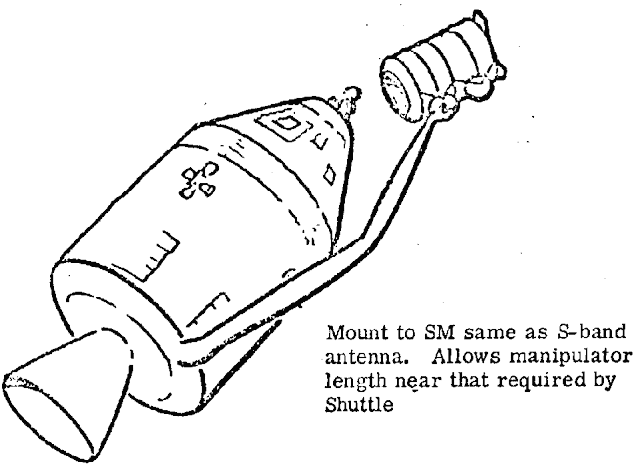
Caldwell Johnson's depiction of a prototype Shuttle manipulator arm with a hand-like end effector. The manipulator grasps the Docking Module meant to link U.S. Apollo and Soviet Soyuz spacecraft in Earth orbit during the Apollo-Soyuz Test Project (ASTP) mission.
Johnson estimated that new hardware for the ASTP Shuttle manipulator demonstration would add 168 pounds (76.2 kilograms) to the CM and 553 pounds (250.8 kilograms) to the SM. He expected that concept studies and pre-design would be completed in January 1973. Detail design would commence in October 1972 and be completed by 1 July 1973, at which time CSM-111 would undergo modification for the manipulator demonstration.
Johnson envisioned that MSC would build two manipulators in house. The first, for testing and training, would be completed in January 1974. The flight unit would be completed in May 1974, tested and checked out by August 1974, and launched into orbit attached to CSM-111 in July 1975. Johnson optimistically placed the cost of the manipulator arm demonstration at just $25 million.
CSM-111, the last Apollo spacecraft to fly, reached Earth orbit on schedule on 15 July 1975. By then, Caldwell Johnson had retired from NASA. CSM-111 carried no manipulator arm; the tests Johnson had proposed had been judged to be unnecessary.
That same month, the U.S. space agency, short on funds, invited Canada to develop and build the Shuttle manipulator arm. The Remote Manipulator System — also called the Canadarm — first reached orbit on board the Space Shuttle Columbia during STS-2, the second flight of the Shuttle program, on 12 November 1981."
source
#Apollo–Soyuz#Apollo Soyuz Test Project#ASTP#Apollo CSM Block II#CSM-111#Rocket#NASA#Apollo Program#Apollo Applications Program#Canadarm#Shuttle Manipulator Arms#Skylab Orbital Workshop#Skylab OWS#Skylab#Skylab I#Skylab 1#SL-1#Space Station#Apollo Telescope Mount#ATM#Cancelled#Cancelled Mission#my post
41 notes
·
View notes
Text


how i’d be dressing if a) trends in fashion hadn’t conspired against me since before my birth and b) i could find more soviet/DDR surplus that fit me
27 notes
·
View notes
Note
Hello! I’ve been hunting for the longest time, and you seem like you’d be knowledgeable about this subject than I, but what online marketplaces would be the best sites to seek out vintage clothing from the USSR/eastern europe in general? Preferably with sellers that would be willing to ship internationally, as I’m in the US. The small sum of Soviet clothing that’s washed up on our shores over the decades is mostly military paraphernalia, and while I do love a good surplus jacket I’m looking for normal civilian clothing. My experience with Russian consignment sites is pretty cursory, limited to browsing Youla, Avito, and the like.
Hi! There isn't truly a market for vintage clothing in Russia. Not a lot to begin with I guess (esp. comparing to the US) and it wasn't great quality in general. Online, I would start with Avito. (The thing about Avito and the like is that you have to talk to people before buying something.)
I also know a few shops in Moscow/St Petersburg that I would go to for clothes, in paticular Chumodan or the Vintage Universal Store. (I don't know if they ship internationally.) (Or speak English). I've seen a few Russian online sellers that specialize in vintage clothing - but it won't be Soviet clothing. It'll be vintage as in before 2010 and mostly European/American vintage. Maybe FreakFrak.
All these shops have active social media (VK) so be sure to check that out if you can.
29 notes
·
View notes
Text
GE PowerHaul

After I offered, @valtionrautatiet-official asked me to post some pictures of the locomotive that is nowadays known as the Dr20, used by the private freight operator North Rail in Finland. Here it is in 2012, long before anyone ever even considered sending it to Finland, in Berlin. The reason that it's in Berlin specifically is that it's at Innotrans, the biggest trade fair and exhibition for railroads that exists. At this point it had the paint job of HHPI (Heavy Haul Power International, despite the important sounding name really just one of many European freight rail companies with headquarters in Germany), with their trademark blue and red and their company policy of putting Newton's second law on it. "Project Power" also sounds cool, doesn't it? Well, it turns out they never entered service for HHPI. Way too much history under the cut.
The story behind these eight locomotives is weird and opaque, and there is a lot of stuff we may never know, but on a very fundamental level it seems to be one of the victims of what I call the six-axle diesel curse. This basic of that theory of mine is that it's impossible to sell big, heavy, powerful diesel locomotives, the kind that are so powerful that they need six axles for all the weight from their big engine and diesel tank, in (West) Germany and to a certain extent central and Western Europe, at least nowadays, unless you do it by accident.
The German locomotive industry has wanted to build big six-axle diesel locomotives since the end of steam traction. There was a prototype six-axle version of the V 200, named V 300, in the 1950s, but DB didn't want it (a related but less powerful version was sold to Yugoslavia to haul Tito's private train). For the Americans here, the Krauss-Maffei locomotives of the Southern Pacific and Rio Grande were related to that.
A few years later, in 1962, we get the V 320, a six-axle version of the V 160 locomotive family. The four-axle version was very popular and is still in service, but they only built the prototype of the six-axle version. Interestingly, that one prototype is still around as well, hauling construction trains. Deutsche Bahn was never interested, they preferred the flexibility of having more smaller units. And anyway, they were busy electrifying the busy main lines that would have made the most use of those heavy machines.
In the 1970s Henschel and BBC (the electric equipment one, not the British TV one) built three copies of the DE 2500 both with four and six axles, but those were really more experimental machines.
In the late 1980s and early 1990s, MaK tried to sell their DE 1024, and I actually have a picture of that ne.
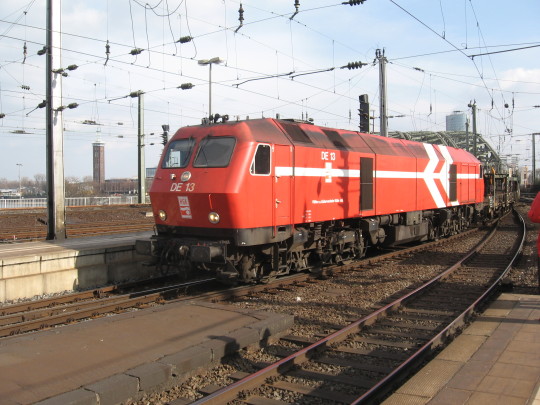
They built three prototypes, and Deutsche Bahn seemed to genuinely toy with the idea… but in the end it was decided to electrify the lines in the (mostly flat) north that hadn't been electrified yet anyway.
And at the same time, the wall fell, and suddenly Germany had access to all the locomotives of the east, now mostly surplus since mostly the industry they served did not survive the transition to western markets. East Germany had bought powerful six-axle diesel locomotives in enormous numbers from the Soviet Union, specifically modern-day Ukraine, and those were available, good enough and already paid for. In particular the class 232 and related, known as "Ludmilla" among rail fans, have proven very useful.
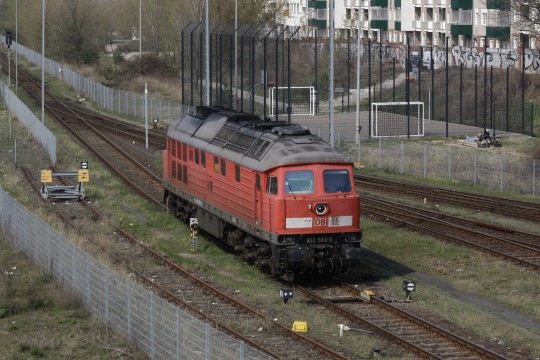
MaK was able to sell an altered version of that locomotive to Norway, but that turned out to be be a huge disaster as they developed a habit of catching on fire. Eventually Siemens (who briefly owned MaK) had to take them back, and since then they've changed hands an astonishing number of times - apparently right now Hector Rail and RDC Autozug have a lot of them. Here's one in Hamburg Altona when it was used on regional trains there.

The three prototypes went to locally owned operator HGK, where two of them also burned down. DB probably dodged a bullet there. Interestingly enough, the only one that didn't burn down was number 13, but that was finally scrapped a few years ago.
In the mid-1990s, ADtranz (later Bombardier) and GE got together to build the Blue Tiger locomotive, a very distinctive-looking and noisy machine. They sold 11 to various private operators in Germany, 30 to Pakistan and 20 to Malaysia. Not terrible, but not a huge success either.
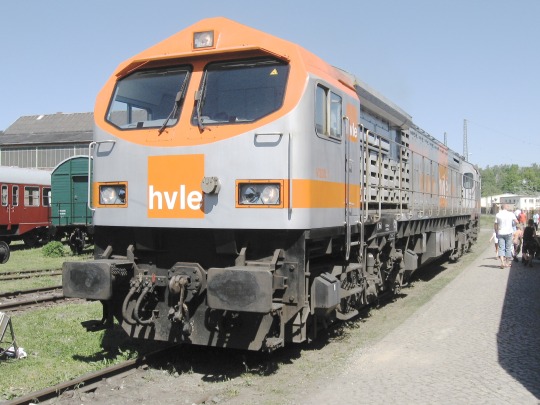
But in the 2000s, things were changing. Liberalisation meant that more and more companies were running services all throughout Europe. The busy main lines were electrified, but many of the border crossings weren't yet, so there was a new need for big six-axle diesel locomotives.
The big beneficiary of this was EMD from North America, who were already supplying such locomotives to Great Britain. The rail companies there needed these machines to replace unreliable British-built power, and to replace environmentally friendly electric locomotives, because most of the British network is not electrified and the few sections that are have way too much traffic on them.
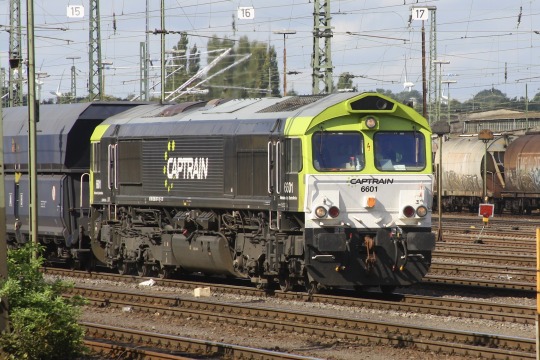
The Class 66 is an ugly mess, designed by figuratively building a metal shed in the inside of a tiny British rail tunnel. It's so noisy that drivers in Norway get hazard pay for being in them. But it works and it was mass produced, and a lot of them made their way to the continent in short order.
Other companies wanted in on that business. Voith decided to enter locomotive building after previously supplying traction equipment. They had high hopes for their Maxima series of locomotives, which they started building in 2008, and they had their own leasing company. They did a lot of marketing and the machine won prestigious design awards.

At one point they had a hundred pre-orders. In the end their own leasing company folded, and they only built twenty, which they didn't even manage to sell that quickly. Nowadays they've stopped producing locomotives again.
General Electric, the other North American locomotive company, wanted in on that action as well. Sure, it hadn't worked with the Blue Tiger, but years had passed and things were different now. For their new product, the PowerHaul, they decided to follow what EMD had done. They started with the class 77 for the British market, first shown at Innotrans in 2010.

Then they wanted to work their way out to wider Europe, with a special continental version that was designed with a bigger shell to match the larger tunnels on the continent. That way they weren't quite as cramped. EMD had considered a similar idea, a European-sized class 66, but decided against that.
GE also did not intend to make them themselves. Instead after the initial batch of British 77s, they transferred production to their Turkish partner Tülomsaş, who supplied some more British ones and the ones for central Europe. 29008 is one of them.
In the end all of these plans fell through. A lot of the international border crossings did get electrified much quicker than the diesel sellers had hoped. The one near where I live, the Montzenroute, started electric running in December of 2008, and it was actually the makers of electric locomotives who made bank off of the new international railway world. Here is a Bombardier TRAXX electric locomotive during the first week that freight trains from Germany to Belgium were running with electric power, just a few hundred meters from the border.
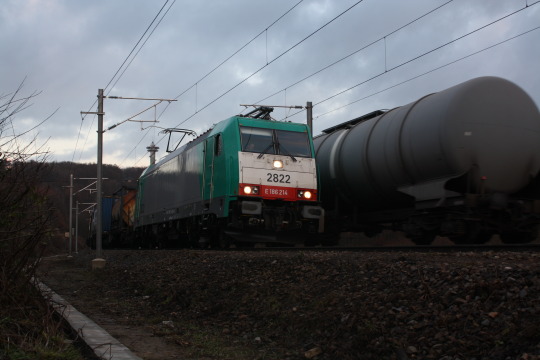
But the business changing is one thing, the story of the PowerHauls seems to be even more complicated. After all, GE did have a launch customer for their PowerHaul, in the form of HHPI. The locomotives were built, painted in HHPI colors, and tested. And then… well, nothing. They never entered service, instead sitting for years in Cottbus, Germany. I have no idea whether they ever got approved for service in Germany. Finnish Wikipedia says "HHPI had no use for them", but that sounds like a euphemism. Clearly HHPI had some use for powerful locomotives, they've recently taken delivery of some Stadler EuroDuals.
The EuroDual and the closely related Euro9000, pictured below, seem to be the solution to the six axle diesel curse though the conceptually simple but technologically difficult trick of simultaneously being a very powerful electric locomotive as well. They have already delivered more of them than Voith Maxima, GE Blue Tiger and GE PowerHaul combined. Sorry for the pictures, they don't park the locomotives well for good photos at Innotrans.
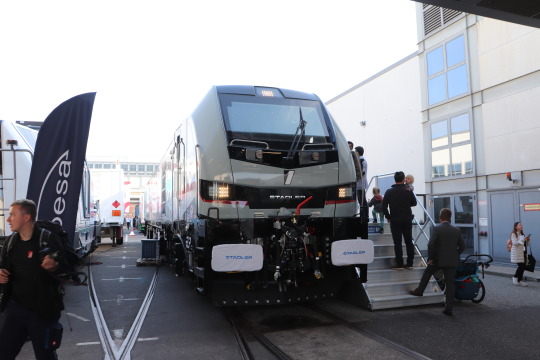
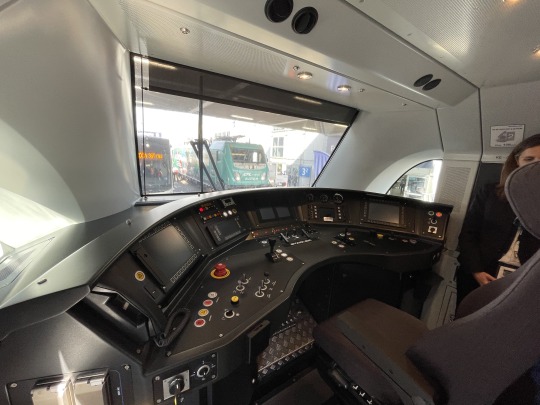
Also, GE was not able to find any customer in Germany, nor in Sweden, where some units of that type were tested at some point. Locomotives of that type were built for Turkey, though, and I haven't heard anything negative about them there. Those were also at Innotrans, in 2014.
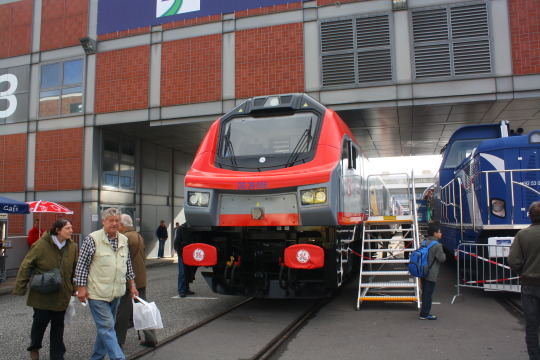
And then, years after everyone had forgotten about these machines, they suddenly turned up in Finland, in the hands of North Rail (formerly Operail), one of the few private companies there. That required at least new couplings, new axles (Finland has a different rail gauge, the measurement of how far the rails are apart), probably adjustments to the breaks, new train control systems and so on.
It's possible that North Rail was thoroughly convinced by the advantages of GE's concept or something, but I think it's far more likely that they just got a really good deal because GE was happy someone took them off their hands.
The reason they're in Finland is almost certainly that Operail needed some cheap machines that weren't doing anything, and these units were just that. But why were they not doing anything? Why were these machines doomed to sit in Cottbus for years, essentially still in new condition, painted for an operator that didn't want them? I'm sure you'll find plenty of theories if you look on online forums, and it's even possible that one of them is the truth, but unless some rail journalist decides to really dig into that, we'll probably never know for certain.
If you allow me to speculate: It certainly doesn't sound like a success story, and there have been all sorts of other stories where trains didn't get approval to run in the country they were ordered for, or had severe technical defects. Ask an Austrian rail fan about the Talent 3, a danish about the IC 4 or a dutch or Belgian about the Fyra to get some really fun rants. I don't know if these locomotives belong in that hall of shame, but it would certainly be an explanation.
My guess is that there won't be any more of these machines ever. GE Transportation doesn't even exist anymore, the whole part of the business got sold to Wabtec a few years ago. But if these machines are doing well in Finland now, good for them! Finally someone found something to do with these weird-looking units.
16 notes
·
View notes
Text
OURO PLOT SYNOPSIS (1900-2042)
the full plot synopsis up to the canon present-day for the story i’m working on. will hopefully update this w links which go over characters/topics in more detail eventually, for now all future links are highlighted in red. i guess i’m not opposed to answering questions here too so if you would like to do that go right ahead
1900-2000
The Mallory family, wealthy British industrialists, grew to prominence by capitalizing on the newfound radium industry in the 1910s. Many in the Mallory family were distinguished doctors who studied the esoteric, and some of its notable figures established The New Disciples of Mesmer: a scientific community that follows and expands upon F. A. Mesmer’s theories of “animal magnetism.” According to this group (who call themselves the neo-Mesmerians), humans who possess supernatural abilities can and have existed all throughout history, and are the result of a surplus of “mesmeric materials” within the body. Rather than magnetic fluids as originally proposed by F. A. Mesmer, neo-Mesmerians instead suggest that the concentration of electrolytes within organic tissues influences mesmeric potential.
Vigorous experimentation was performed in an attempt to create these “magnetics” that F. A. Mesmer described in his literature. In the mid-1960s, after all attempts to create a magnetic in-vitro failed, they subjected numerous people, mostly expectant mothers, to experimental chromosomal tests. These tests were largely executed in Soviet Russia and other Central Asian countries where the Mallorys had significant political standing due to their radium mining operations. They finally succeeded in 1981 with the birth of Hena Safarova, a bicephalic chimera (fraternal twins fused in the womb, where each hemisphere of the brain has a unique set of DNA).
Hena is raised in one of the Mallorys’ remote Uzbek labs, where it is discovered she possesses extracorporeal abilities as a magnetic. These include mind-reading, a primitive form of hypnosis, and manipulating electric fields. To better differentiate the term “magnetic,” they instead call her a “conjugate.” Hena’s mother died during a traumatic childbirth, and she is looked after by the lab employees. One of which is Olma Safarova, the estranged sister of Hena’s mother working as a nurse in the Mallory lab to find out why her sister disappeared. When Hena is five, Olma attempts to stage an escape, but is caught and killed by security. In a rage, Hena uses her extracorporeal abilities to kill Orville Mallory, the head of the Mallory estate who happens to be at the scene. Unbeknownst to her and everyone else, he is actually her father, having meddled with the earlier chromosomal experiments.
The public fallout surrounding the incident forces the Uzbek lab to close. Cassandra Mallory, the adult daughter of Orville and half sister to Hena, upon learning they share the same father, decides to raise her herself in Liverpool and renames her Mia. Mia is further experimented on throughout her childhood. She is eventually trained to be a neurosurgeon, as her mind-reading abilities (“clairvoyance”) give her detailed insight into the workings of the brain. Due to her trauma of watching Olma die trying to set her free, she is passive to her captors well into adulthood, though she is also given clairvoyance-suppressants to keep her from being a threat.
2000-2011
In the early to mid 2000s, after years of being unable to create another bicephalic chimera, new research is done to find if there is a way to expedite the process. Mia, with Cassandra as her supervisor, is tasked with this. During her studies she establishes Base Theory, and proposes that another type of conjugate can be created in-vitro. This conjugate would come from the egg of a bicephalic chimera, and then be pseudo-fertilized by electric stimulation. While promising, these tests ultimately failed.
Around this time, Oman Khurshid, a Pakistani engineering graduate, is working as a lineman in Lahore. His father has not been in his life, his aging mother is suffering from a malignant brain tumor, and he has become stretched thin as her sole caregiver. Oman is also a closeted trans man and dreams of gaining control of his life someday. In 2009, he gets a job offer from Mallory labs to work as an equipment technician in the UK. They express their interest in neuroscience, and promise that if he fulfills a two-year work contract, they will help heal his mother’s cancer. He accepts, not knowing this is a ploy to further their research into conjugates.
Oman is assigned to work in the Liverpool lab, where Mia works. They meet when Oman takes his lunch outside to eat, and Mia’s on her smoke break. Due to her sheltered upbringing, she quickly attaches to Oman, asking him about his life outside the lab. They develop closer friendship when he’s tasked with repairing some of her testing equipment.
Meanwhile, Oman’s mother, Yushfa, is tended to by the Mallorys’ doctors. Instead of providing her treatment, however, they instead plan to harvest her brain for EBID, or electro-biological imprint data. EBID is predicted to resolve the issue of conjugate eggs being unable to be pseudo-fertilized by simple electric stimulation. Unfortunately Yushfa is too weak and dies during the surgery. Oman is not told this.
In 2010, Cassandra approaches Oman and asks if he would be willing to undergo the same experimental procedure as Yushfa. She tells him that on top of taking care of his mother’s treatment, he will also be rewarded a cash payout equivalent to about $500,000. He agrees to it, but Mia tries to dissuade him in secret. Not knowing his mother’s fate, or Cassandra’s true motives, he brushes her off and they have a falling out.
On the day of his surgery, he realizes that Mia will be the one holding the knife. She again tells him to walk away, but he doesn’t listen. Mia, against her will, performs a craniotomy just above his left eyebrow to the tip of his ear, and extracts a small fragment of his frontal cortex. He survives, and is promptly released by the Mallory lab to do as he likes.
Upon returning to Lahore, Oman cannot find his mother. Their shared apartment is now being lived in by someone else, and the Mallory estate now claims that his mother was never accepted into their care. When the authorities don’t take him seriously, he tries to lay low while he investigates on his own.
Meanwhile, the conjugate experiments are set to begin a new set of trials. Cassandra has collected 19 EBID samples from different individuals. She gives Mia a choice on which sample to perform pseudo-fertilization, as she will be the one responsible for bringing the conjugate to term. She picks Oman’s, but this riddles her with guilt and she falls into a deep depression. The experiment is a success.
From February to July of 2011, while the new conjugate is growing, Oman begins to experience vivid hallucinations, seeing images of Mia and his Yushfa, along with a voice calling him. These are the result of the new conjugate connecting to him and trying to communicate. When the new conjugate is born on July 1st, she is named Samantha. Testing is quickly started to chart her development and observe her clairvoyant abilities. It is established early on that she possesses mesmeric properties even more powerful than Mia.
In December, Oman has reached a near-manic state. Samantha is constantly probing his mind, asking him where he is and to come find her. He thinks it’s all in his head until he notices that the hands of his watch quiver during these episodes. He jerry-rigs a number of electronic devices to find the source of the disturbance, and concludes it must be back in Liverpool.
He abandons everything in Lahore and travels back to the UK lab. By climbing a utility pole he’s able to break inside, and finds a six-month old Samantha in the facility. Mia finds him soon after and tells him to run away, but Cassandra quickly discovers them and shoots him. She misses his heart and the bullet instead goes through his shoulder, giving him the opportunity to take Samantha and escape. With the staff distracted, Mia starts a fire in the lab and follows after him. He shortly thereafter blacks out as Mia tends to his wounds and escorts them to the British countryside. For the next 20 years, they keep themselves hidden from the neo-mesmerians whilst also trying to give Samantha (renamed Samya to hide her identity) a somewhat normal life.
2011-2019
Upon the catastrophic disaster following Mia and Samya’s escape, the Mallorys are desperate to find a new bicephalic chimera. When unsuccessful, they comb through all known records of living conjoined twins, but this too turns up no leads. It’s only by following a seemingly dead-end in India they discover they might be onto something. Mona Nibhanupudi was a fused twin until age four when he and his sister were separated while in foster care. He was told that she had died during the procedure, but her medical records were lost. However, Mona believes that his sister is still alive, and says that they possessed a magic that let them see “the ribcage of the world” before they were separated. The Mallorys eagerly search for the missing twin, who Mona tells them is named Deepali.
In 2016 during an experimental procedure, Mona is given back his clairvoyance. Also created is The Conduit, an enigmatic entity that lives on the electrical grid. With his regained abilities, Mona is asked to seek out Oman and Mia in order to return Samya to the Mallorys. He also begins work developing consciousness transfers with great success. The Conduit, however, is hindering his progress and proving to be a nuisance.
At this time, The Conduit is conspiring with Neha Viswanathan, a robotics PhD candidate at NISER, to retrieve a “soul” from the Mallorys. In return, it promises to reveal to her the truth behind sentience and how to create AI.
In 2019, Mona manages to lure Oman and Mia into a trap, where Mia is incapacitated and captured. Oman’s rescue mission and The Conduit’s scheme cross paths, and in the chaos Cassandra is murdered. A traumatic brain injury leaves Mona non-clairvoyant. Cassandra’s consciousness is transferred at the brink of death, but the lack of oxygen in her brain during the process leaves her digital self cold and emotionally distant. Now free, Mia continues to see Oman and Samya, but is notably absent. The fate of Neha and The Conduit is unclear.
2019-2029
Once recovered, Mona continues with his consciousness transfer technology in light of the failure. In that same year he announces the first sentient AI robots, which he calls “krtrim posthumans.” He and the Mallorys collaborate to establish OURO, a robotics company that quickly gains popularity. This popularity also brings in protest, with some governments completely outlawing so-called “consciousness transfers” because it challenges god or the nature of the earth. Through the international turmoil, OURO continues to grow.
Unbeknownst to the world, Mona has kept a krtrim posthuman for himself, which he names Deepali after his sister. He raises her as his surrogate daughter of sorts, but he is eccentric and not a very fatherly figure in her life. She is not allowed to leave his sight and lives alone with him on his rural estate outside of New Delhi.
In 2029, Mona travels to the United States at the peak of posthuman conflict to meet with the American president. He leaves Deepali to her own devices and promises to return. Shortly after arriving, Mona is found dead from an apparent overdose in his hotel room. Conspiracies arise and governments begin pointing fingers at one another, accusing each other of poisoning Mona in an effort to put an end to the posthuman revolution. After attempts of political meddling and the deaths of numerous politicians in surprise bombings, war is declared. OURO is contracted to create soldiers for the cause, giving them an even greater revenue stream that allows them to expand from India to Japan, where they begin building more factories. Krtrim posthumans that were previously created are now “repossessed” so their bodies can be recycled to make soldiers. Many flee to Central Asia and the Middle East to escape repossession.
Shortly after his death, Mona’s home is stormed by authorities. Deepali escapes to the streets of New Delhi, where she joins another krtrim marked for repossession named Viggy. Together they attempt to reach Bangladesh, but they’re caught and Viggy is killed. In turn, Deepali tries to end her own life but is subdued before she can.
Deepali is brought into the custody of the Mallorys, who did not know of her existence. Thinking Mona was using her to hide information, she is imprisoned and interrogated relentlessly. Dr. Emelie Yadavalli is assigned as her robopsychologist, but after over a year of depositions and invasive procedures into her mind, it’s obvious Deepali knows nothing about her father’s past. She falls into a sickness known as corruption and nearly dies, but Emelie takes pity on her and rehabilitates her. The Mallorys, now disinterested, allow Emelie to purchase her vessel-hood.
2029-2042
From 2029 to 2030, what’s become to be known as the Tangent War ravages much of Europe, North America and Asia. Nuclear warfare begins when OURO’s new location in Osaka is nuked along with much of Japan, rendering most of the country uninhabitable. The only countries to escape with minimal damage are India, China, and South America, who largely are not involved in the war. Following the destruction and fearing total societal collapse, the remaining governments form The Transhumanistic Peace Treaty (THPT), which establishes laws and rights for posthumans. Mia goes missing around this time.
In the wake of such a large-scale loss of infrastructure, governments invested heavily in rebuilding. From this the style of architecture known as nayafuturism emerges, taking inspiration from brutalism and mid century modern elements. Public transportation in the form of trains, monorails and cable cars have become common.
The main plot takes place 13 years after the Tangent War ended. Samya, now an adult, has a very rough falling out with her father, who she believes is hiding the true whereabouts of her mother. She does some digging into her past, but most people involved are either dead or nowhere to be found. Suddenly, she receives a tip that Mona Nibhanupudi has a daughter named Deepali living in Auxiliary, a coastal city east of London which houses OURO’s European industrial branch. Upon finding her working as a simple electronics assembler, Samya is surprised to learn she’s krtrim, not human. Stranger still is that she is seemingly immune to Samya’s mind reading, which makes getting answers out of her difficult. They eventually team up to uncover the mysteries behind their respective families.
24 notes
·
View notes
Text
The collapse of the Soviet bloc was certainly a contributing factor. But it’s bigger than that. Take Theda Skocpol’s classic work on social revolution, which is generally held to be the model of scholarship on the topic. Skocpol sees social revolutions as rooted in a particular type of social formation, what she calls an agrarian-bureaucratic society. Agrarian-bureaucratic societies are societies in which the surplus produced by peasants is essentially shared between a government and an aristocratic or landed elite that’s in alliance with the government. This is the classic type of society that was vulnerable to social revolutions throughout the nineteenth and twentieth centuries.
Accordingly, social revolutions historically were closely connected with land inequality and lack of access to land. They typically occurred in peasant societies. Even when mobilization in social revolutions occurred in cities and was led predominantly by urban classes, the peasant element was still prominent. But by the late twentieth century, that agrarian-bureaucratic society had begun to fade.
What happened? Well, a third of the world experienced communist revolutions that wiped out that aristocratic landed class altogether. Then you had land reform in other places that occurred as a result of the threat of social revolution and that was aimed at undermining its potential. Land inequality is still quite extensive around the world. But a lot of land has been redistributed to populations in many places, and that has mitigated elements of the social revolutionary impulse.
Then you have the massive migration of people into cities. Who are the people who migrate into cities? It is typically young men, the very same people who are most likely to participate in armed rebellion. When they migrate to cities, they leave behind a disproportionately older and female population in the countryside that often depends upon wages earned in the cities and remittances sent back to the village. So access to land is no longer as important as a source of subsistence, and often it’s access to wages in cities that has taken its place. You also have developments like the green revolution in the countryside, which has increased productivity in the countryside in some countries, so that people can produce more.
Finally, one of the main solvents of that aristocratic class has been democratization. Studies show that the power of the aristocratic, landed elite tends to be undermined through democratic reforms.
All these factors taken together have undermined agrarian-bureaucratic society. So social revolutions as we traditionally knew them no longer occur, not just because of the end of the Cold War and the Soviet Union. The Soviet Union didn’t create social revolutions. The role of the Soviet Union was essentially to provide arms to revolutionaries. Rather, the conditions that underpinned these revolutionary conflicts have deteriorated, and instead large numbers of people have moved into cities. This movement of large numbers into cities instead created a conducive environment for the urban civic model of revolution.
13 notes
·
View notes
Text
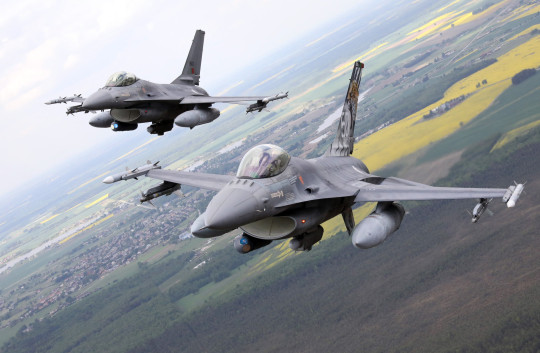
F-16 fighters will bring better weapons and radar to the Ukrainian Air Force
There are negative points of the F-16 for Ukraine, but the positive points are greater.
Fernando Valduga By Fernando Valduga 12/20/2023 - 17:00 in Military, War Zones
The F-16s will make Russian pilots think twice before entering Ukrainian airspace, say experts interviewed by Reuters for a detailed assessment of their impact on the war.
The F-16s from several European countries are now in training centers in Romania, Denmark and the USA and the first Ukrainian pilots, those who speak English fluently, will soon be in training. Much has been said about used fighters, which have become surplus as their previous owners re-equipmed with the F-35. They will help, but the military officers are apparently trying to explain the expectations.

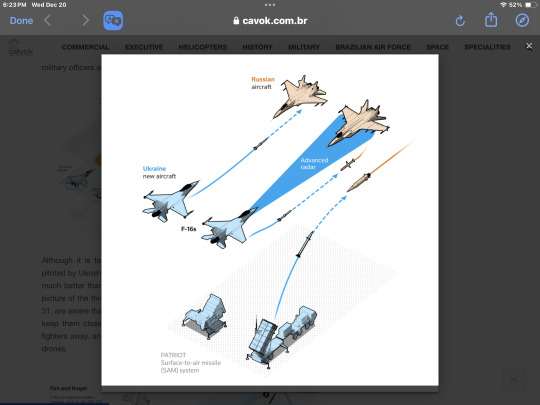
Although it is faster and more agile than the 40-year-old MiG 29 and Su-27 now piloted by Ukrainians, the main benefit of the F-16 is in its nose. Its radar systems are much better than the old Russian hardware, giving pilots a much longer and clearer picture of the threat environment. The Russians, who pilot the newer Su-35 and MiG-31, are aware that they will be more visible to the Ukrainian F-16s and that this should keep them closer to home. Ukraine has been using ground-to-air missiles to keep fighters away, and the arrival of the F-16 will free them to go after cruise missiles and drones.

To keep up with the sophisticated radar, the F-16 uses air-to-air sho-fir and forget missiles, where Ukraine's current equipment requires guidance from the aircraft to take the missiles to their target. This makes the aircraft vulnerable and greatly increases the number of wasted shots. The F-16 has also evolved into a multifunctional fighter air defense platform that can be used for air superiority and ground attack. Lockheed Martin has refused to detail how the Vipers bound for Ukraine will be configured.
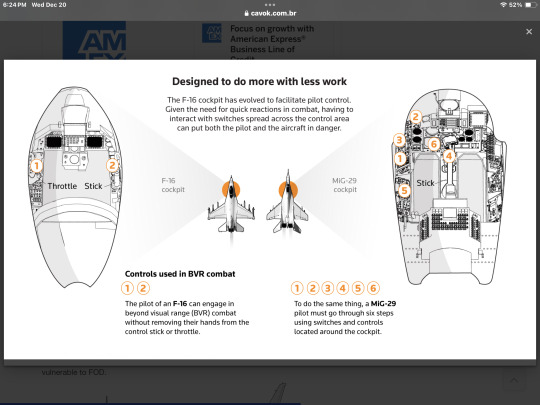
There are some deficiencies that may limit the implementation of F-16. The planes are relatively fragile and are not suitable for the pavement destroyed in the unimproved fields on which Ukraine depends heavily. With this large intake of debris, they are also vulnerable to FOD.

Russian aircraft have secondary air intakes above the wings so that the main entrances can be closed for ground operations. "The F-16 is a precious aircraft, it is fragile," Kelly Grieco, a senior researcher at the Stimson Center, told Reuters. "It's an aircraft that needs a long runway and the runway is very flat. But they are in an environment where (Ukrainian pilots) have been performing distributed operations. ... This is not an aircraft that can do that."

Perhaps the most important thing that the F-16 offers Ukraine is hope for the future. Although it can still get spare parts from other countries of the former Soviet Union, support for the old Russian planes will end and Western equipment is the only option for Ukraine, both in the short and long term. It is expected that as Ukrainian pilots get used to the simplified controls, ergonomic layouts and operations of the F-16 logical system, they will quickly adop the new ways of doing things.
Tags: Military AviationF-16 Fighting FalconWar Zones - Russia/Ukraine
Sharing
tweet
Fernando Valduga
Fernando Valduga
Aviation photographer and pilot since 1992, he has participated in several events and air operations, such as Cruzex, AirVenture, Dayton Airshow and FIDAE. He has works published in specialized aviation magazines in Brazil and abroad. He uses Canon equipment during his photographic work in the world of aviation.
Related news
HELICOPTERS
Tata Boeing Aerospace has already manufactured 250 AH-64 Apache helicopter fuselages
20/12/2023 - 16:00
MILITARY
Canada orders the remotely piloted air system MQ-9B SkyGuardian from GA-ASI
20/12/2023 - 12:00
MILITARY
Philippines closest to acquiring Saab JAS39 Gripen fighters
20/12/2023 - 11:00
MILITARY
IMAGES: Hungarian Gripens perform deployment exercise on a dispersed basis
20/12/2023 - 08:36
MILITARY
Armed Overwatch program needs to slow down until SOCOM justifies the fleet, says GAO
19/12/2023 - 21:17
MILITARY
IMAGES: Portugal performs first aeromedical transport with its KC-390
19/12/2023 - 17:52
6 notes
·
View notes
Text
fun fact: all the guns in Goncharov are historically accurate except one:
In the shootout on the bridge, one of the guys behind Ice Pick Joe Morelli's truck has a folding metal stock on his gun instead of a fixed wooden one, but they didn't make folding stocks for those guns until after the soviet union broke apart. The prop department probably got a military surplus one for cheap to pad out the numbers for the that scene.
62 notes
·
View notes
Text
Midwest winter survival pro tip. Go find a website that sells soviet/eastern european military surplus and order a jacket from there. Ive never been so warm..but i do look like im supervising the gulags
4 notes
·
View notes
Text
nobody in the world replies faster than an armenian ebay guy selling off soviet surplus
14 notes
·
View notes
